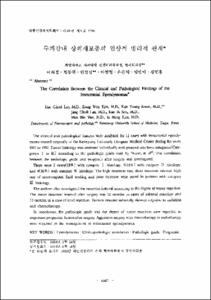KUMEL Repository
1. Journal Papers (연구논문)
1. School of Medicine (의과대학)
Dept. of Neurosurgery (신경외과학)
두개강내 상의세포종의 임상적 병리적 관계
- Keimyung Author(s)
- Kim, Dong Won; Lee, Jang Chull; Son, Eun Ik; Yim, Man Bin; Kim, In Hong; Kwon, Kun Young
- Journal Title
- 대한신경외과학회지
- Issued Date
- 1994
- Volume
- 23
- Issue
- 9
- Abstract
- The clinical and pathological features were analyzed for 11 cases with intracranial ependymona treated surgically at the Keimyung University. Dongsan Medical Center during the years 1987 to 1992. Tumor histology was reviewed individually and grouped into the three categories(Categories Ⅰ to Ⅲ) according to the pathologic grade used by Nazar, et al. The correlation between the pathologic grade and prognosis after surgery was investigated.
There were 2 cased(18%) with category Ⅰ histology, 5(45%) with category Ⅱ histology, and 4(36%) with category Ⅲ category. The high recurrent rate, short recurrent interval, high rate of cerebrospinal fluid seeding and poor outcome were noted in with category Ⅲ histology.
The authors also investigated the recurrent interval according to the degree of tumor resection. The mean recurrent interval after surgery was 12 months in cased of subtotal resection and 33 months in a case of total resection. Tumors resected subtotally showed response to radiation and chemotherapy.
In conclusion, the pathologic grade and the degree of tumor resection were regarded as important prognostic factors after surgery. Aggressive surgery with chemotherapy or radiotherapy were required in the management of intracranial ependymoma.
- Alternative Title
- The Correlation Between the Clinical and Pathological Findings of the Intracranial Ependymomas
- Publisher
- School of Medicine
- Citation
- Dong Won Kim et al. (1994). 두개강내 상의세포종의 임상적 병리적 관계. 대한신경외과학회지, 23(9), 1047–1054.
- Type
- Article
- ISSN
- 1225-8245
- Appears in Collections:
- 1. School of Medicine (의과대학) > Dept. of Neurosurgery (신경외과학)
1. School of Medicine (의과대학) > Dept. of Pathology (병리학)
- 파일 목록
-
-
Download
 oak-bbb-1673.pdf
기타 데이터 / 528.78 kB / Adobe PDF
oak-bbb-1673.pdf
기타 데이터 / 528.78 kB / Adobe PDF
-
Items in Repository are protected by copyright, with all rights reserved, unless otherwise indicated.